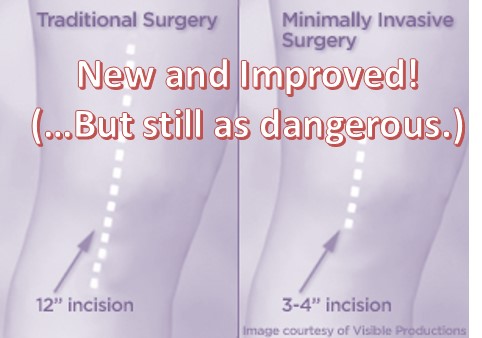Is Minimally Invasive Knee Replacement Safer? Is a Big Surgery any Safer than a Really Big Surgery?
Is Minimally Invasive Knee Replacement Safer?
Are there fewer minimally invasive knee replacement complications? There are buses where I live that have signs advertising a new “minimally invasive” knee replacement surgery. Patients likely sign up for this type of knee replacement because they think it’s less invasive and has fewer complications than the full knee replacement. After all, just look at the difference above in incision size! However, what if that isn’t true?
A minimally invasive knee replacement is one where only a part of the knee joint is replaced rather than all of the joint. This means the device the surgeon implants is smaller. The reasoning is that a smaller device means a smaller incision, less surgery time, a shorter recovery, and fewer side effects. A research group decided to see if that was true by tracking two groups of patients, one who got the minimally invasive surgery and another who got the full Monty. They matched the patients by age, sex, and anesthesia risk as well as the fact that they were getting both knees replaced. The minimally invasive knee replacement group did have shorter times in the operating room and a shorter length of hospital stay. Some complications are literally from the smaller incision itself, like tissue stretching and tearing, and a smaller visual field for the surgeon to work with and limits on the device type. However, all in all, the number of big complications were identical between the two groups!
The upshot? The term “minimally invasive” has been stretched beyond the point of recognition by medical marketers. This term was once reserved for injection procedures that replaced surgery. Now it’s also slapped on big surgeries that are smaller than the really big surgeries. Hence, it comes as no surprise when a “minimally invasive” knee replacement turns out to be pretty invasive.

If you have questions or comments about this blog post, please email us at [email protected]
NOTE: This blog post provides general information to help the reader better understand regenerative medicine, musculoskeletal health, and related subjects. All content provided in this blog, website, or any linked materials, including text, graphics, images, patient profiles, outcomes, and information, are not intended and should not be considered or used as a substitute for medical advice, diagnosis, or treatment. Please always consult with a professional and certified healthcare provider to discuss if a treatment is right for you.

